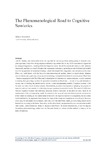Mostrar o rexistro simple do ítem
The phenomenological road to Cognitive Semiotics
| dc.contributor.author | Sonesson, Goran | es_ES |
| dc.date.accessioned | 2014-10-02T12:31:42Z | |
| dc.date.available | 2014-10-02T12:31:42Z | |
| dc.date.issued | 2012 | es_ES |
| dc.identifier.citation | Culture of communication / Communication of culture, 2012: 855-865. ISBN: 978-84-9749-522-6 | es_ES |
| dc.identifier.isbn | 978-84-9749-522-6 | es_ES |
| dc.identifier.uri | http://hdl.handle.net/2183/13389 | |
| dc.description.abstract | [Abstract] Like M. Jordan, who discovered in his old age that he had always been talking prose, I realized a few years ago that I have been doing cognitive semiotics my whole life. In my 1978 dissertation I argued for an «integral linguistics», meaning both that linguistic theory should be conceived within a wider semiotic framework, and that we should abandon the «autonomy postulate», according to which theoretical models must be independent of empirical findings, which dominated both linguistics and semiotics at the time. When you build theory with the help of a phenomenological method, there is a much shorter distance between theory and experience, because phenomenology is empirical attention to consciousness. Much later I became acquainted with Paul Bouissac’s description of semiotics as «meta-analysis», which «consists in reading through a large number of specialised scientific publications/…/ in one or several domains of inquiry, and of relating the partial results within a more encompassing model». Cognitive science is for the most part also a kind of meta-analysis. Nevertheless, semiotics has interest in adopting the practice of cognitive science that consists in submitting its own questions to empirical study. The essential difference between cognitive science and semiotics, however, resides elsewhere, in the point of view taken in the construction of the encompassing model. In semiotics, the point of view that determines the construction of the model is meaning in the widest sense of the term. In cognitive science it is cognition, but in a sense itself redefined by the approach, first, during the reign of the computer metaphor, as everything in the mind which may be simulated on a computer, and then, with the later brain model, as everything which can be detected as occurring in the brain. Semiotics, on the other hand, has generated its own reductionist models from within, most notoriously those of Saussure and Peirce. To avoid reductionism, it will be argued, Husserlean phenomenology, rather than the Peircean brand, is a more suitable method to employ in the study of meaning | es_ES |
| dc.language.iso | eng | es_ES |
| dc.publisher | Universidade da Coruña | es_ES |
| dc.title | The phenomenological road to Cognitive Semiotics | es_ES |
| dc.type | info:eu-repo/semantics/conferenceObject | es_ES |
| dc.rights.access | info:eu-repo/semantics/openAccess | es_ES |






